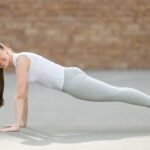Dumbbell Front Squat: Exercise Overview
The dumbbell front squat is a dynamic compound exercise designed to target the quadriceps, glutes, and hamstrings, with secondary engagement of the core, upper back, and shoulders. By holding dumbbells at shoulder level, this variation promotes an upright torso and emphasizes quad strength, making it a valuable alternative to barbell squats for building lower-body power and stability.
This exercise enhances functional strength, improves posture, and supports athletic performance, making it ideal for leg-focused workouts, lower-body sessions, or full-body routines. The dumbbell front squat is accessible for various fitness levels and allows for customization based on mobility and strength, supporting both aesthetic and functional goals (Schoenfeld, 2010).
How to Perform the Dumbbell Front Squat
- Stand with feet hip- to shoulder-width apart, toes pointing forward, holding a dumbbell in each hand with a neutral grip, resting them on your shoulders or balanced above your elbows.
- Engage your core, retract and depress your shoulder blades, and tuck your elbows close to your sides to maintain an upright torso—this is your starting position.
- Initiate the squat by pushing your hips back and bending your knees, lowering your body to a depth where you can maintain proper posture (typically until thighs are parallel to the floor or knees reach a 90-degree angle).
- Pause briefly at the bottom, keeping weight distributed evenly from heel to ball of foot.
- Drive through your feet to return to the starting position, maintaining a straight back and upright torso throughout.
- Repeat for the desired number of repetitions.
Tips for Optimal Performance
- Maintain Proper Posture: Keep your chest lifted, shoulders back, and spine neutral to prevent slouching and reduce lower-back strain (McGill, 2010).
- Control Knee Alignment: Ensure your knees track over your toes without caving inward or outward to protect the joints and maintain stability (Escamilla et al., 2001).
- Keep Elbows Tucked: Prevent your elbows from flaring out to maintain dumbbell stability and emphasize upper-back engagement.
- Distribute Weight Evenly: Balance your weight between the heel and ball of your foot to engage both quads and glutes effectively, avoiding excessive forward lean.
- Breathe Properly: Inhale as you lower into the squat and exhale as you push back up to support core stability and muscle oxygenation (Wirth et al., 2016).
- Adjust Depth for Comfort: Squat only to a depth that allows you to maintain proper form, especially if mobility is limited, to avoid compromising alignment.
Building quads with front squats? Explore how they fit into our Ultimate Guide to Muscle Groups for leg strength.







